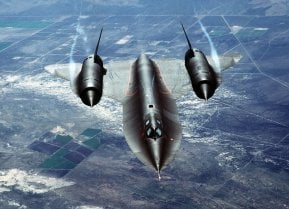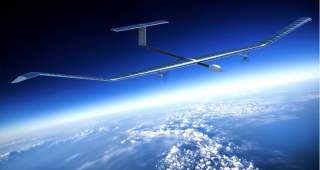Britain’s New Spy Planes Are Practically Spacecraft
Zephyr is a technical marvel, but can it do the job?
DARPA de-funded the program in 2012, but Boeing’s designs included the same high-altitude motors used on the Zephyr.
The Defense Department hosted the next test flight in 2008. Between July 26 and 31, Zephyr flew for 82 hours and 37 minutes — three and a half days — at the U.S. Army’s Yuma Proving Ground in Arizona. Controlled by autopilot and satellite link, Zephyr carried a six-pound U.S. government dual-channel air-ground VHF radio up to 62,000 feet.
This was a new record for an unmanned aircraft, but because no official from the record-keeping Fédération Aéronautique Internationale was present to witness the flight, it wasn’t official. But Zephyr had stomped Global Hawk’s own, unofficial 34-hour record into the ground — and the team was far from done.
“We think Zephyr is very close to an operational system — within the next two years is what we’re aiming for,” chief engineer Chris Kelleher — who sadly died in the summer of 2015 — told the BBC after the Arizona test flight. “We have one more step of improvements. We trying to design a robust and reliable system that will really sit up there for months. And we want to push the performance.”
While Zephyr 6 continued testing with the U.S. Naval Air Warfare Center, Qinetiq began work on Zephyr 7.
This iteration was, until very recently, the current prototype. It could fly more than a month with a daytime altitude of 65,000 feet — and 45,000 feet at night. At 73.8 feet, it was 50-percent larger than its predecessor — and weighed 110 pounds.
This increased weight was in part due to it carrying more batteries than Zephyr 6 did. The new model also carried a downward-looking camera and a forward-looking optical/infrared camera to help operators fly the aircraft from the ground.
After being launched by hand, a pilot at a container-based ground station remotely controlled the plane until it reached the minimum altitude for the autopilot to kick in. Once aloft, the autopilot could navigate between GPS waypoints or, when necessary, the ground station operator could take manual control.
The aerodynamic profile of Zephyr had also changed. The wings now had the inverted V-shape of a cartoon seagull, and its tail featured a high T-shaped configuration.
The Qinetiq team returned to Yuma Proving Ground with the new model in July 2010 where it once again smashed the endurance record. The aircraft managed more than 14 days of continuous flight — 336 hours and 22 minutes — at a maximum altitude of 70,740 feet. This time an official from the Fédération Aéronautique Internationale was there to witness the flight, putting the flight into the record books.
This unmanned airplane endurance record stands as of August 2016.
From this point, the record-breaking was over. In December 2010, Qinetiq started pitching Zephyr as a war-ready military surveillance and communications platform, but in reality it was still very much in a prototype form.
In 2013, Qinetiq divested the project to EADS Astrium which then became Airbus Defense & Space later that year. The Zephyr teams at Qinetiq and Airbus have since pushed forward with a truly production-ready model.
Technical marvel:
Zephyr represents an incredible achievement. Operating at a region of the atmosphere where most aircraft attempt to spend as little time as possible, Zephyr is subject to all sorts of engineering challenges.
At its operating ceiling, Zephyr flies high above the wind and weather, but it’s extremely vulnerable during its ascent and descent through the windy troposphere — the region of the atmosphere we inhabit.
During testing, Zephyr was only launched in perfect weather conditions— although Qinetiq press releases repeatedly played up the ground temperature and storms around the test days. But that is not to downplay the effects of the desert temperatures it faced on the ground.
From around 40º Celsius at launch, Zephyr’s ambient temperature would fall 2º Celsius per 1,000 feet. But the aircraft mostly flies in and around the ozone layer, which absorbs the sun’s ultraviolet light and emits the energy as heat. As a result, the ambient air temperature actually begins to rise once Zephyr ascends past 65,000 feet.
Once Zephyr gets out of the dense tropospheric air and into the stratosphere, it also has to increase its power usage to maintain propulsion.
When night falls, the aircraft must descend to 45,000 feet to conserve power by flying in more dense air. Here the temperature falls to as low as -80º Celsius. This extreme cold can cause components to become brittle, affect electronics and cause metal components to contract.
The engineers chose to insulate and heat components to protect them, even though that increased Zephyr’s weight. But given these extreme temperatures, it isn’t possible to fully protect each component from thermally-generated expansion and contraction.
Cosmic rays — energetic particles emanating from space — are an additional threat to the platform’s electronics. Zephyr operates right in the peak region for cosmic radiation. These rays can cause data corruption and critical electronic faults and it is unclear how much shielding Zephyr 7 carried to protect against this threat but it reportedly hasn’t suffered any ill effects … yet.
Zephyr operators will also face challenges resulting from its solar-power generation. The amount of solar energy available to any given surface area varies by latitude and date. The tropics offer the most energy, but the farther from the equator you go, the more significant the drop-off in available energy during winter.
This means that Zephyr is limited in where it can operate, depending on the season. It’s unlikely that Zephyr will be patrolling Britain for months on end outside summer, for example. But that doesn’t mean it’s entirely incapable of operating during winter. In August 2014, Zephyr 7 flew for more than 11 days in an undisclosed southern hemisphere location in order to show that it could operate for long periods despite winter’s longer nights.
Besides the importance of Zephyr’s atmospheric and climatic requirements, it suffers several structural limitations. It has to be extremely lightweight with very long wings. The weight of the payload, motors, batteries and solar panels are evenly distributed along the wings in the upper atmosphere, but down on the ground, these wings droop under their own weight. Zephyr operators will have to be very careful when launching and stowing the aircraft or risk stress fractures — or worse.
In addition, the lightweight requirement necessitates design compromises. Each component must provide a strong power-to-mass ratio. For Zephyr 6, at least, its amorphous silicon solar cells featured photovoltaic layers that were micrometers in thickness. This made them around 10-percent efficient compared to thicker commercial cells.
Its lithium-sulphur batteries, although lighter than lithium-ion, lagged behind in efficiency. They required constant heating to 20º Celsius in order to maintain their efficiency and also needed to be housed in fire-suppressing containers in order to prevent self-combustion catastrophes.
Ultimately, Zephyr’s major impediment is its limited payload capacity. Zephyr 6 could carry a measly six pounds compared to Global Hawk’s 2,000 pounds or AeroVironment’s Global Observer’s 400 pounds. All these concerns about weight are necessary to ensure that Zephyr can not only fly, but also perform its required missions — but it seems unlikely that Zephyr’s packages could ever reach the efficacy of its competitors.
Its payloads must not only be carried up to altitude, but also must be powered by its solar panels. This suggests that existing jet-based payloads will not be entirely suited to Zephyr operations.
Zephyr is the closest we have to an eternal-vigilance aircraft, but it can’t meet all of its operators’ information, surveillance, target acquisition and reconnaissance needs. It will fill a small part of a commander’s toolbox, at least until battery and camera technologies allow for less strain on the fragile balance that keeps it aloft.
British Zephyrs:
The British military expected to receive its three Zephyrs in 2017 under a £13-million contract. Britain stated its intent to purchase Zephyr in its National Security Strategy and Strategic Defense and Security Review 2015, after which then-prime minster David Cameron told Parliamentthat “British-designed unmanned aircraft will fly at the very edge of the earth’s atmosphere and allow us to observe our adversaries for weeks on end, providing critical intelligence for our forces.”
Despite the Ministry of Defense’s silence on the actual purpose of its Zephyr purchase, the Strategic Defense and Security Review offered a major hint. “[British Special Forces] will have the information they need, including through our investment in advanced high-altitude surveillance aircraft,” the review stated.
In 2916 British Special Forces were spotted training Syrian rebels. A platform such as Zephyr flying out of Cyprus — where the U-2 currently operates — could provide always-on signals and imagery to commanders back home, as well as provide current intelligence- and data-support to troops on the ground.
Zephyr 8 — or Zephyr S as it will be known for its production run — has an 82-foot wingspan, but it’s also 30-percent lighter despite carrying 50 percent more batteries. This leaves more space for its 11-pound payload.
Zephyr S probably represents the evolution that was necessary for the platform to pick up production contracts. Zephyr S carries high-definition optical/infrared cameras, narrow-band mobile communications with a 100-megabits-per-second broadcast capacity. Its NIIRS 6 camera can produce imagery with a resolution of up to 15 centimenter for objects on the ground.
At the Farnborough Airshow in July 2016, Airbus announced the Zephyr T — a larger, twin-tail design with a wingspan of 108 feet, capable of carrying a 44-pound payload on its larger 136.6-pound air frame. Airbus is planning a full-scale build in 2018 before the aircraft becomes operational the following year.


